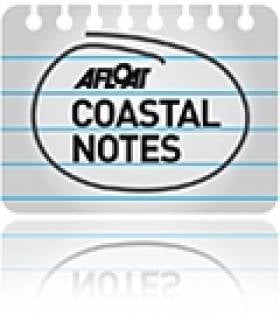Displaying items by tag: Buoys
Waves Setting Records Around Irish Coast
#WaveRecord - The waves just keep getting higher off Ireland's coast!
Following our report in January this year that the M3 weather buoy measured the second highest wave off the West Cork coast comes news of an even bigger swell just a few weeks later.
Met Éireann's Columba Creamer informs us of a maximum individual wave height of 21.91 metres recorded on the night of Monday 23 February.
That's more than two metres clear of the previous record set by the MM3 weather buoy in January 2013, and marks the fourth highest wave recorded across Ireland's buoy network.
But there's more, as Monday 26 January saw Ireland's biggest ever wave – a 23.44-metre whopper – recorded by the M4 buoy off Donegal.
Creamer – Met Éireann's port meteorological officer, who quality controls data streams from Ireland's buoy network – says the four Fugro buoys (labelled M2, M3, M4 and M5) measure significant wave height, individual wave height, swell height, wind wave height, period and direction for each wave type.
Hard-Working Vessels Keep Lights Switched-On
Sailing was not the only activity that took place in Dublin Bay last Saturday as the Northern Lighthouse Board's (NLB) multi-function tender NLV Pharos was busy at work, writes Jehan Ashmore.
The NLB is the Scottish equivalent of the Commissioners of Irish Lights (CIL) and it is not unusual for such vessels to share work duties beyond their respective jurisdictions. The 84m NLV Pharos is equipped with dynamic positioning and a 30-tonne main crane on her 300m2 aft-deck.
Overall she is similar in appearance to Irish lights ILV Granuaile which is based out of Dun Laoghaire. The Irish Lights tender built in Romania in 2000 tends to operate more often off the west coast during the summer months due to the more favourable weather conditions.
The 1,300 (dwt) deadweight tonnes NLV Pharos yesterday returned to her base in Oban from her Irish duties. The west coast base was established in 1904 and is also homeport to the service's smaller NLV Pole Star which is equipped with an 18-tonne crane on her 90m2 aft deck.
The facility in 2000 underwent a £4.2 million redevelopment to turn a buoy yard into a multi functional support base which is computer-linked to the NLB headquarters in Edinburgh.
In addition Trinity House which maintains the service for England and Wales operate the tenders THV Galtea,THV Patricia and the fast-response craft THV Alert from their base in Harwich.
Trinity House forms the trio of the General Lighthouse Authorities (GLA) alongside NLB and CIL. Each member of the GLA co-operate in the allocation of vessel-tender deployment.
Asides the varied and critical role of the tasks performed by the GLA's tenders, they are also available for charter to third parties. Between them the tenders can conduct buoy and chain work, search and rescue, lighthouse re-fuelling, salvage and recovery, towing, hydrographic applications and ROV work.

























































